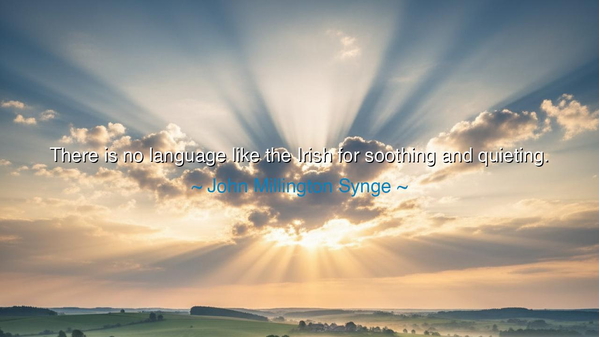
There is no language like the Irish for soothing and quieting.






In the poetic and tender words of John Millington Synge, “There is no language like the Irish for soothing and quieting,” we hear a tribute not only to words, but to the soul of a people. Synge, the dramatist and poet who captured the rugged beauty and spirit of Ireland, was not merely praising a language for its sound—he was speaking of its power to heal, to comfort, and to restore. For language, when born of the earth and the heart, becomes more than speech; it becomes a melody that carries memory, emotion, and belonging. The Irish tongue, shaped by centuries of sorrow and song, holds within it the gentleness of lullabies, the rhythm of the sea, and the strength of those who endured. To hear it, even softly spoken, is to be reminded that words can cradle the spirit as tenderly as a mother soothes her child.
The origin of this quote lies in Synge’s deep immersion in the Irish language and culture during the late 19th and early 20th centuries, when the Gaelic revival sought to reclaim a heritage nearly silenced by colonization. He traveled to the Aran Islands, living among the fishermen and peasants who still spoke Irish Gaelic as their daily tongue. There, he discovered not only a language, but a way of being—rooted in nature, humility, and truth. In its lilting cadences and quiet strength, he found a serenity that modern life often forgets. When he said that no other language was so “soothing and quieting,” he spoke of a language that carried peace, not in grandness or eloquence, but in its simplicity and sincerity.
The ancients understood well that the language of a people is the reflection of their soul. The words they speak are the vessel of their history, their laughter, their prayers. Among the Celts, language was sacred; it was said that words could bless or curse, heal or wound. The druids spoke of “briathar,” the living word, as something that carried divine power. The Irish language, born of this ancient lineage, was crafted by centuries of poetry and song. It is a tongue that does not hurry; it lingers, allowing the weight of silence and sound to breathe together. Even its lullabies—suantraí—flow like rivers of calm, filled with imagery of moonlight and waves. To speak Irish is not simply to communicate—it is to sing life itself, to weave comfort through rhythm and tone.
Consider the story of Douglas Hyde, another great voice of Ireland’s revival and the founder of the Gaelic League. He once told of a famine widow he met in the West of Ireland, whose only possessions were a few scraps of food and the language she spoke. When he asked her to recite a poem in Irish, her eyes brightened, and her voice transformed from weariness to beauty. Her words, though simple, carried a music that transcended her poverty. She spoke of the fields, the rain, and the hope of spring. When she finished, Hyde said he felt as if the whole landscape had spoken through her. That is the soothing power Synge describes—the power of a language not to deny hardship, but to make it bearable; not to erase pain, but to give it voice so gentle that the soul can rest.
The Irish language is woven with images of peace. The word for calm, síocháin, sounds itself like a sigh of relief; the word for love, grá, feels like the warmth of an embrace. Even when describing sorrow, the Irish tongue does so with grace. There is a rhythm to its phrasing that allows emotion to flow without violence, to heal instead of wound. Synge heard in it a reflection of the Irish heart—resilient, lyrical, and kind. It is a language of endurance, shaped by a people who learned to find music even in mourning. In their words, they carried serenity through centuries of struggle, proving that language can be both a weapon and a balm—and that, in the hands of poets and mothers, it becomes a song that soothes nations.
Yet Synge’s insight extends beyond Ireland—it speaks to the universal truth that every language has its spirit, and within that spirit lies the power to comfort those who speak and hear it. In every culture, there are words that heal: lullabies whispered to children, blessings given to travelers, prayers spoken over the dying. What Synge reminds us is that language is not merely sound—it is the heartbeat of belonging, the bridge between human hearts. When spoken with tenderness, it can quiet storms of the mind and rekindle light in the soul.
Let this, then, be the lesson passed down through generations: cherish the language of your people, for it carries your ancestors’ peace. Speak not only to be understood, but to heal, to bless, to comfort. In an age where words are often sharp and hurried, return to the gentleness of speech—the kind that listens, the kind that soothes. For as Synge teaches us, the true power of language lies not in its cleverness, but in its ability to quiet the heart.
Thus, in the enduring words of John Millington Synge, we find both poetry and prophecy. His praise of the Irish tongue is not merely for its melody, but for its spirit—for the way it gathers silence and speech into harmony. The Irish, with their history of endurance, made of their language a refuge—a home for the heart amid exile. And in this, Synge speaks for all humanity: that there is no sound more soothing, no word more sacred, than one spoken with love. For where words heal, there too dwells peace—and through them, the world remembers how to be whole again.






AAdministratorAdministrator
Welcome, honored guests. Please leave a comment, we will respond soon